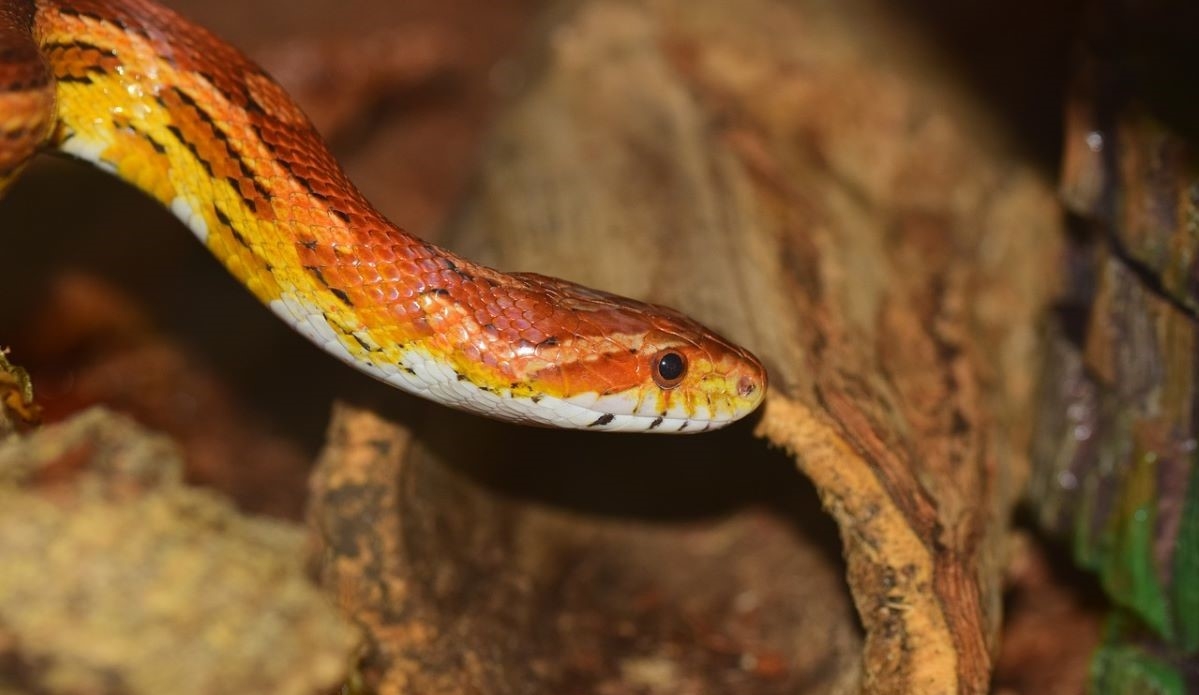
The best way to care for a pet corn snake
A pet corn snake is perhaps one of the friendliest reptiles you can ever keep. These snakes are usually docile and easy to tame them. They are relatively active and inquisitive, making them an ideal choice as a per for either adults or children. Corn snakes originate from North America and you can find them in various colors which are known as morphs.
Therefore, if you have come to a stage in your life where you think that keeping a reptile as a household pet is pleasant and convenient, your best option is a corn snake pet. However, before you take a plunge on buying a pet corn snake, you need to know the best ways to care for them. This post will show you how you can choose the best pet corn snake and create a perfect corn snake’s environment.
What you should consider before you buy a corn snake
All snakes are not the same, just as each person is different from one another. Hence, you will encounter some snakes that are docile, tame, and tolerant to you handling them while others can be pretty temperamental. If it’s your first time to keep a snake as a pet, you want to have a snake that you’re capable of handling it.
The rule of thumb is that you should always start small when you want to become a snake owner. Besides, you should choose a healthy reptile that you can house, feed, and take care of them for the rest of its life. Many people love to buy corn snakes because they are docile and for their appealing colors.
You can find these snakes in a variety of color patterns and are quite easy to handle. Because they are widely available, it can be overwhelming to choose the right snake that matches your desires.
Remember that corn snakes can be bred in captivity but some of them are wild-caught. Regardless of whether they were bred in captivity or they were caught in the wild, they all have a variety of morphs and sizes. Some of these colors include orange, white, red, gray, and stripped. Each of the snakes requires the same care needs, so it depends on you to choose the one that is most appealing to you.
Choosing a healthy corn snake
When choosing a pet corn snake, you need to go for the healthy one. You can check if your corn snake has a solid muscular body and is rounded with tapering to the tail. Also, they have bright eyes and clean and smooth scales.
And, look out for any scrapes or cuts on the snake. Above all, a healthy corn snake shouldn’t have any signs of illness and it has to be alert to your presence by flicking its tongue.
When it comes to signs of illness, you must check for any potential problems. Below is what you need to look out for while examining a corn snake:
- Protruding ribs and backbone and poor muscle tone. Run gently with your closed hand through the snake. As you’re doing this, try to feel for irregularities, such as odd lumps, indentations, and many other abnormal features.
- Respiratory infections. Puffiness on the throat or whistling can be a good sign of respiratory infection. Therefore, listen to the corn snake as it’s breathing and check if it has liquids coming out from its mouth or nostrils.
- External parasites. This is easy to notice because you just need to check for any parasites on the snake’s body. You can run your hand down its body to see if ticks or other parasites are clinging to it. Snakes can usually have parasites around their body orifices.
- Nervousness. It’s quite normal for a snake to defend itself against anything it perceives as a danger to their lives, like your approaching hand. Hence, you should expect any type of aggression but it usually goes away quickly as they get used to you.
- Life background. You can ask for any recorded history on how the snake was kept, how it was fed, and the type of environment it was kept. This type of information can help you to understand how competent the previous owner was.
How to care for a corn snake in its enclosure
From the onset, it’s a good idea to decide whether you want to buy a hatchling corn snake or older ones. Keep in mind that hatchling corn snakes are usually more fragile than adult corn snakes, meaning you need to give them adequate time to get used to handling.
The good part is that hatchling corn snakes are quite cheaper and have captivating corn snake colors than adults. They also take about 2 years to grow to a fully adult corn snake, so it might be worth it to get what you desire.
On the other hand, while older corn snakes are big and impressive, they generally have duller and darker colors. People sell older corn snakes for various reasons, but you need to be careful because they can have some hidden problems, like reproductive issues.
That said, you should always be aware of the corn snake’s natural habitat in the wild. You see, these snakes can live in a variety of environments, like grasslands, pine forests, rocky areas, and around grain stores and farms. While they can spend most of their time on the ground, they enjoy climbing. Therefore, a great enclosure for your corn snake should consider the following factors:
Size of the enclosure
Thankfully, corn snakes don’t require large enclosures to live a healthy life while in captivity. After all, it’s believed that large open spaces can be stressful for your pet corn snake. For this reason, a suitable enclosure can be a medium-sized fish or vivarium tank that has a tight-fitting lid. But a hatchling should be kept in a smaller fish tank.
Here is a good plan of how you can house a corn snake. You should consider giving an allowance of about 1 square foot floor space for each foot of your corn snake.
Interestingly, corn snakes have perfected the art of escaping, so make sure that the lid to their housing is always secure. This means you should fasten the lid because corn snakes are pretty strong and they are capable of pushing off a loose-secured lid and running away.
Some pet corn snake owners prefer using specially designed vivariums or fish tanks which you can find in different sizes. Others use the Really Useful Boxes which can become a great home for your corn snake as long as you drill some air holes. But you need to make sure that these holes are small to prevent your reptile friend from getting stuck or escaping.
Best of all, Really Useful Boxes come with fasteners on both sides to keep the housing fastened. These boxes can also be useful for transporting your corn snake, or they can act as a temporary house while you’re cleaning their main house.
Options for substrates
There are various substrates that you can use for your corn snake. Many people prefer aspen shavings which you can get from most pet shops or online. These substrates are popular with most pet owners because they are soft, absorbent, and can hold their shape when your corn snake burrows. You can spot-clean as needed, but you need to remove aspen shavings between 4 and 6 weeks.
The best way to take care of the aspen shavings is by feeding your snake outside of its house or you can put its food in a separate container inside. In this way, you will prevent your snake from consuming some of the substrates that are stuck to the food. Unfortunately, if your corn snake can consume the substrate by accident, it can likely become ill.
Cypress mulch also makes a suitable substrate for your corn snake. However, don’t use aromatic woods like cedar or pine because they can be toxic. Alternatively, you can consider using paper towels that include kitchen rolls.
The best place to use these towels is under your corn snake’s house. The good news is that these towels are cheap and easy to replace. You can also use them under the aspen shaving to help you to clean the house easier.
Enrichment of corn snake’s habitat
Corn snakes deserve to have proper decorations and furnishings to make their surroundings attractive. But you don’t need to find those that are specifically designed for your pet reptile as long as they are safe. So you can consider using rocks, branches, and plastic plants. These can provide your snake with a chance to climb, hide, and explore within its environment.
The bottom line is that corn snakes should be allowed to hide but this should be within their house. You see, snakes like to hide in the cooler and warm parts of the fish or vivarium tank. For corn snake hiding sites, you opt for specialized hide-outs or use common items like terracotta plant pots.
It’s normal for snakes to seek hide-outs because they tend to avoid threats. Therefore, without a proper hideout, there is a risk that they can be unhappy and stressed. As a result, your corn snake can refuse to feed that can contribute to its poor health.
Provide heat
Corn snakes are considered as cold-blooded reptiles, meaning they need to get heat from their immediate surroundings to stay warm. In their natural habitats, a can snake can move in and out of places that are sunny as needed so that they can regulate their body. Hence, when you house a corn snake, you should place bulbs and heat mats as an alternative source of heat.
A vivarium or fish tank should have a temperature that is 21 to 30C. However, a heat mat should only cove at least half of the floor space. In this way, your corn snake can have cooler and warm spaces. A thermostat should also be incorporated to monitor and regulate the heat produced inside the enclosure.
For a light bulb, it needs to have a metal cage to provide heat. But you have to make sure that you put enough safety measures to protect your pet corn snake from the heat burns. This is the reason why a thermostat is necessary to regulate the temperature but you should put them at both ends of the enclosure. Mind you, corn snakes don’t require light throughout the day as they can be stressed by the constant lighting.
Feeding your corn snake
Corn snakes enjoy eating mice, so you can feed it a frozen mouse which you can buy from pet shops or online. But the size of the mouse will usually depend on the size of your snake. The best way is to feed your snake with mice that are one and half times the size of your pet’s head.
A hatchling might need to feed on one young mouse that is pink at least every after 6 days but they should be given one adult-sized mouse as they grow. One they get older, the corn snake tends to feed much less, so it can take between 7 and 14 days without feeding. However, avoid handling your corn snake after feeding as this can lead to regurgitation of food.
A corn snake requires to be given fresh drinking water daily. You can give them in a solid bowl that cannot tip over once your snake attempts to drink the water. Corn snakes also like to bath in the water when they are about to shed their skin.
Corn snakes can shed their skin several times a year throughout their lifespan. While they have no problem with shedding, you can still render your hand to help them. The ideal way is to place a bowl of water inside their enclosure. As explained earlier, your snake will bath in the water bowl or the rise in humidity inside the enclosure will help loosen off their old skin.
After each shed, make sure that all the skin came off, especially on the tail tip and around their eyes. If there is still some skin remaining, you can gently rub it or use tweezers while the corn snake is taking a bath in warm water.









